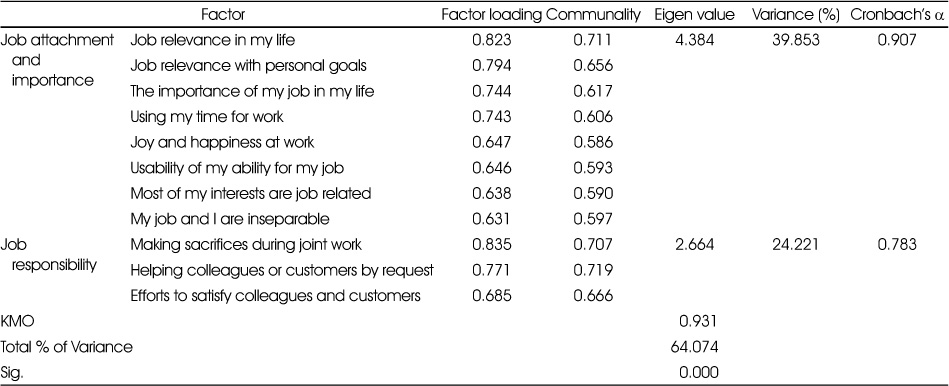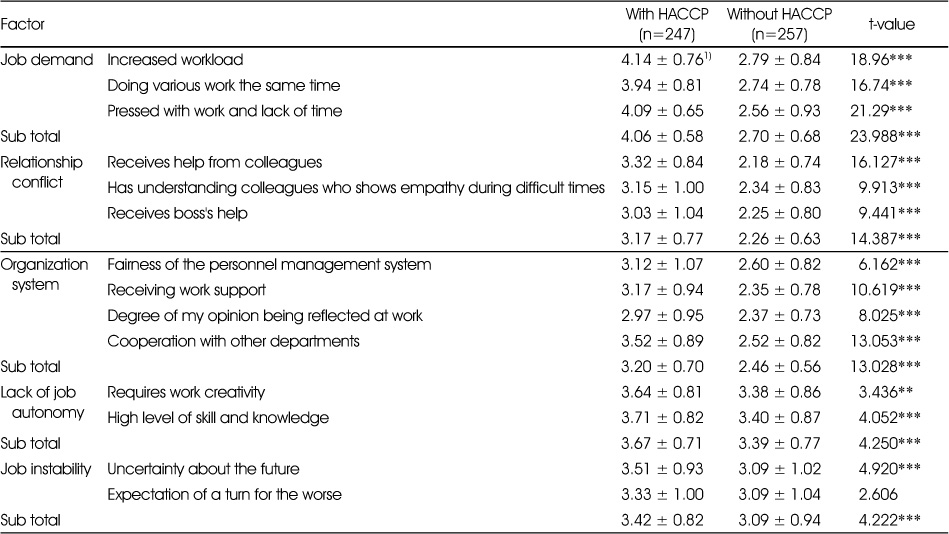Articles
- Page Path
- HOME > Korean J Community Nutr > Volume 23(1); 2018 > Article
-
Research Article
- A Comparative Study of Job Stress, Satisfaction and Commitment of Cooking Employees in Hotel Kitchens with and without HACCP Systems
-
Kyung-Cheon Min, Wan-Soo Hong

-
Korean Journal of Community Nutrition 2018;23(1):28-37.
DOI: https://doi.org/10.5720/kjcn.2018.23.1.28
Published online: February 28, 2018
Department of Foodservice Management and Nutrition, Sangmyung University, Seoul, Korea.
- Corresponding author: Wan-Soo Hong. Department of Foodservice Management and Nutrition, Sangmyung University, Honggimun 2-Gil, Jongno-Gu, 03016 Seoul, Korea. Tel: (02) 2287-5350, Fax: (02) 2287-0104, wshong@smu.ac.kr
Copyright © 2018 The Korean Society of Community Nutrition
This is an Open-Access article distributed under the terms of the Creative Commons Attribution Non-Commercial License (http://creativecommons.org/licenses/by-nc/3.0/) which permits unrestricted non-commercial use, distribution, and reproduction in any medium, provided the original work is properly cited.
- 855 Views
- 3 Download
Abstract
-
Objectives
- This study was conducted to identify differences in job stress, satisfaction and commitment of cooking employees working in hotel kitchens with and without HACCP systems.
-
Methods
- Culinary employees of 12 five-star hotels were surveyed and 504 valid data were used for SPSS analysis. Sub factors of working environment factors (job stress, job satisfaction, and job commitment) were examined for analysis.
-
Results
- The results showed that hotels that implemented the HACCP system had significantly higher values for the five sub factors of employee job stress (job demand, relationship conflict, organizational system, lack of job autonomy, and job instability; p<0.001). For the sub factors of job satisfaction (internal and external satisfaction) statistic showed a statistically significant value in hotels that did not implement the HACCP system (p<0.001). Job attachment and job importance, which are sub factors of job commitment, showed no difference in relation to the implementation of HACCP system, and job responsibility showed a higher p-value in hotels that did not implement HACCP (p<0.05).
-
Conclusions
- The results of the study indicate that culinary employees working at venues with HACCP systems have more job related stress, lower job satisfaction and partially less job commitment. Based on this outcome, venues that have already implemented or are planning to implement HACCP systems should consider the implications regarding their management of employees. Managerial policies that enhance autonomy, job stability, achievement, self-development, promotion, and compensation should also be implemented. Finally, meticulous attention and high investments into the work environment and human resources are necessary.
Acknowledgments
Acknowledgments
- 1. Choi JG. The consuming trend of customers in the food service industry. Int Soc Tour Ind 2009; 2(4): 127-142.
- 2. Gilmore SA, Brown NE, Dana JT. A food quality model for school food services. J Child Nutr Manag 1998; 22(1): 32-39.
- 3. Holdt CS. Attitudes and knowledge of university food service managers toward sanitation. J Coll Univ Food Serv 1992; 16: 17-24.
- 4. Bryan RL. Impact of food borne disease and method of evaluation control program. J Environ 1984; 47(5): 241-245.
- 5. Bryan FL. Hazard analysis critical control point approach: Epidemiologic rational and application to food service operations. J Environ Health 1981; 44(1): 7-14.PubMed
- 6. Woo IE, Hwang YK, Lee YS. The status and the actual sanitation management conditions of food services within the metropolitan area. Korean J Food Nutr 2008; 21(3): 355-365.
- 7. Edaily news. Re-certification of intercontinental hotel ISO 22000 [Internet]. Edaily news; 2017; cited 2017 Oct 20]. Available from: http://www.edaily.co.kr/news/news_detail.asp?newsId=01590806616029616&mediaCodeNo=257&OutLnkChk=Y.
- 8. Korea Agency of HACCP Accreditation and Services. HACCP certified company status [Internet]. Korea Agency of HACCP Accreditation and Services; 2017; updated 2017 Dec 31]. cited 2017 Oct 20]. Available from: https://www.haccp.or.kr/site/haccp/boardList.do?boardSeq=770&key=2215.
- 9. Korean Statistical Information Service. Number of food manufacturers and restaurants [Internet]. KOSIS; 2006; updated 2017 Dec 29]. cited 2018 Feb 27]. Available from: http://kosis.kr/statHtml/statHtml.do?orgId=101&tblId=DT_1K52B01&conn_path=I3.
- 10. Money today. Intercontinental hotel sanitary HACCP certification [Internet]. Money today; 2004; cited 2017 Oct 20]. Available from: http://news.mt.co.kr/mtview.php?no=2004102115035702608&type=1.
- 11. Byun JS, Park SS, Jo CB. A fact analysis on the level of perception and performance for the HACCP system. J Hotel Resort 2005; 4(2): 423-437.
- 12. Kim HB, Lee SM. A study on perceptional discrepancy the sanitation standard according to F&B service staff's position & workplace in the hotels: HACCP. J Foodserv Manag 2000; 3(2): 87-104.
- 13. Jo WG, Jo CB. The effects of the employees of food industry about the level of HACCP system practice affecting the quality effectiveness and the operation results. J Hotel Resort 2009; 8(1): 39-57.
- 14. Panisello PJ, Quantick PC. Technical barriers to hazard analysis critical point. J Food Control 2001; 12(3): 165-173.
- 15. Bas M, Yuksel M, Cavusoglu T. Difficulties and barriers for the implementing of HACCP and food safety system in food businesses in Turkey. J Food Control 2007; 18(2): 124-130.
- 16. Lee HB, Lee SC. A study on the relationship of job stress, job satisfaction, organizational commitment and turnover intention of policemen. Korean Assoc Organ Stud 2006; 3(2): 83-101.
- 17. Yoon JH. A study on the relationship between job stress, burnout and turnover intention of hotel cooking employees. Jpn Mod Assoc Korea 2004; 9: 213-228.
- 18. Kim HS. A study on the relationship of job stress, job satisfaction, organizational commitment and turnover intention of hotel employees. Int J Tour Manag Sci 2005; 19(3): 203-225.
- 19. Lee JH, Park HS, Park HJ. A relationship of hotel cooks' HACCP product use, job satisfaction, organizational commitment, and organizational performance: centered on deluxe hotels in South Korea. Inst Bus Manag 2015; 38(3): 269-292.
- 20. Csikszentmihalyi M. Flow: the psychology of optimal experience. 1st ed. New York: Harper & Row Inc; 2009. p. 281-303.
- 21. Hong YJ, Kim YW, Kim YJ. The influence of deluxe hotel culinary staff job characteristics on job satisfaction and organizational commitment: focus on the moderating effects of the staff's gender and career. J Tour Sci 2017; 41(5): 155-170.Article
- 22. Jung JW, Cho YB. The effect of the physical culinary environment and work convenience, self-efficacy to job satisfaction of hotel culinary employees. J Tour Leis Res 2006; 18(1): 27-45.
- 23. Choi W, Kwak JH, Kim KH. The effects of hotel open kitchen environment on cooking employees job satisfaction and job commitment. J Hotel Resort 2016; 15(2): 87-102.
- 24. Kim SY, Jeon HW. Effects of hotel employee's personality on job involvement and career involvement: focused on big 5 personality. Int J Tour Manag Sci 2008; 23(2): 239-257.
- 25. Chang SJ, Koh SB, Kang DM, Kim SA, Kang MG, Lee CG, et al. Developing an occupational stress scale for Korean employees. Korean J Occup Environ Med 2005; 17(4): 297-317.
- 26. Weiss DJ, Dawis RV, England GW, Lofquis LH. Manual for the Minnesota satisfaction questionnaire. 1st ed. Minneapolis: Industrial Relations Center, University of Minnesota; p. 120.
- 27. Park IJ. A validation study of the Minnesota satisfaction questionnaire [master's thesis]. Seoul University; 2005.
- 28. Kanungo RN. Measurement of job and work involvement. J Appl Psychol 1982; 67(3): 341-349.
- 29. Ha YJ. Civil servant's motivation and self-regulated learning capability as predictors of their satisfaction achievement and job involvement in relation to online job training [dissertation]. Ewha Women's University; 2005.
- 30. Joo YJ, Ha YJ. Motivation variables as predictors of learning effectiveness and job involvement. J Educ Stud 2005; 36(2): 65-90.
- 31. Kim KY, Yu JB. A study on the cooking environment of tourist hotel kitchen. J Tour Res 1994; 8(1): 359-383.
- 32. Parker DF, DeCotiis TA. Organizational determinants of job stress. Organ Behav Hum Perform 1983; 32(2): 160-177.
- 33. Hamilton V, Warburton DM. Human stress and cognition: an information processing approach. 1st ed. New York: Wiley Ltd; 1979. p. 11-33.
- 34. Robert A, Karasek Jr. Job demands, job decision latitude and mental strain: Implications for job redesign. Adm Sci Q 1979; 24(2): 285-308.
- 35. Cooper CL, Marshall J. Organizational sources of stress: a review of the literature relating to coronary heart disease and mental health. 1st ed. London: Palgrave Macmillan; 2013. p. 3-23.
- 36. HACCP KOREA. HACCP synopsis [Internet]. HACCP KOREA; 2017; cited 2018 Feb 02]. Available from: http://www.haccp.or.kr/site/haccp/sub.do?key=91.
REFERENCES
Figure & Data
REFERENCES
Citations

General demographic characteristics of the subjects
n (%)
Reliability and exploratory factor analysis of the job stress variable
Reliability and exploratory factor analysis of the job satisfaction variable
Reliability and exploratory factor analysis of the job commitment variable
Analysis of difference in job stress with and without HACCP
1) Values are mean ± SD. A 5-point scale was used from 1 (strongly disagree) to 5 (strongly agree).
**: p<0.01, ***: p<0.001
Analysis of difference in job satisfaction with and without HACCP
1) Values are mean ± SD. A 5-point scale was used from 1 (strongly disagree) to 5 (strongly agree).
***: p<0.001
Analysis of difference in job commitment with and without HACCP
1) Values are mean ± SD. A 5-point scale was used from 1 (strongly disagree) to 5 (strongly agree).
*: p<0.05
n (%)
1) Values are mean ± SD. A 5-point scale was used from 1 (strongly disagree) to 5 (strongly agree). **: p<0.01, ***: p<0.001
1) Values are mean ± SD. A 5-point scale was used from 1 (strongly disagree) to 5 (strongly agree). ***: p<0.001
1) Values are mean ± SD. A 5-point scale was used from 1 (strongly disagree) to 5 (strongly agree). *: p<0.05

 KSCN
KSCN







 Cite
Cite


